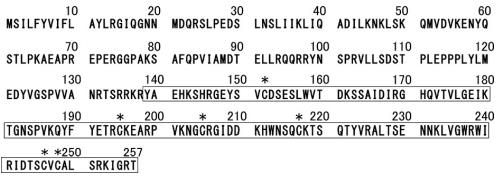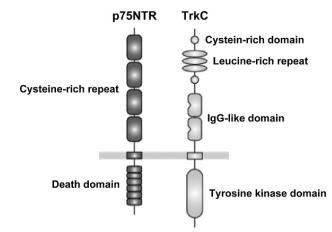NEUROTROPHIN-3, HUMAN
- Product NameNEUROTROPHIN-3, HUMAN
- CAS130939-66-1
- MF
- MW0
- EINECS
- MOL FileMol File
Chemical Properties
| storage temp. | −20°C |
| form | lyophilized powder |
| color | white to off-white |
| biological source | mouse |
MSDS
| Provider | Language |
|---|---|
| SigmaAldrich | English |
Usage And Synthesis
By the 1980s, NGF and BDNF had been isolated and
characterized. The structural similarity between NGF
and BDNF and their restricted neuronal specificity suggest that additional and functionally distinct members of
this family might exist. Then, taking advantage of
sequence identities between NGF and BDNF and polymerase chain reaction, Hohn et al. identified a third member of this family, named neurotrophin-3 (NT-3) in 1990. Within 3 months after the publication of the study, five
studies on the cloning and identification of NT-3 were
published.
NT-3 is a polypeptide consisting of 119 aa residues.
The human NTF3 gene encodes a preproprotein of 257
aa residues (preproNT-3) . After cleavage,
the mature NT-3 dimerizes through noncovalent
interaction. NT-3 has been identified in mammals, birds, reptiles,
amphibians, and teleosts. The amino acid
sequences of NT-3 are highly conserved among vertebrates. Mammalian NT-3 has 100% homology. Six cysteines involved in the intramolecular disulfide bond are
conserved among all vertebrate NT-3s.


Mr. 27,453 (mammalian preproNT-3); 13,625 (mammalian mature NT-3). pI=9.3. NT-3 is soluble in water.
Disulfide bridges are formed between Cys14 and Cys79,
between Cys57 and Cys108, and between Cys67 and
Cys110 (in mammalian mature NT-3).
The human proNT-3 gene, NTF3, location 12p13.31,
consists of three exons. The human NT-3 mRNA has
1182 bases that encode a preproNT-3 of 257 aa residues. ProNT-3 shows broad expression in the ovary (RPKM
4.8), spleen (RPKM 2.1), and 19 other tissues including the
heart, liver, pancreas, kidney, and brain. In the brain,
higher levels of expression are observed in the hippocampus, cerebellum, olfactory bulb, and septam.
NT-3 binds to tropomyosin receptor kinase C (TrkC)
with high affinity, and to TrkA, TrkB, and p75NTR with
low affinity. These receptors are singletransmembrane receptors. Unlike TrkA, TrkB, and
p75NTR, TrkC binds specifically to NT-3. The human
NTRK3 gene encodes TrkC of 839 aa residues. The human
NGFR gene encodes p75NTR of 427 aa residues. TrkC has
a tyrosine-kinase domain in the cytoplasmic region.
There are truncated isoforms lacking the tyrosine-kinase
domain. p75NTR has no tyrosine-kinase domain. The
binding activity of mature NT-3: Kd=10 pM (TrkC)
and 1 nM (p75NTR).


TrkC shows a biased expression in the brain (RPKM
2.8), the fat (RPKM 1.2), and 13 other tissues, including
the endometrium and testis. Prominent expression of
TrkC gene is observed in the hippocampus, cerebral
cortex, and the granular cell layer of the cerebellum. The activation of TrkC promotes the survival and differentiation of existing neurons and the growth and
differentiation of new neurons. NT-3 also enhances
synaptic transmission in the rat hippocampal slices. The role of p75NTR in NT-3 signaling is less clear.
Neurotrophin-3 is the third neurotrophic factor, characterized after
nerve growth factor (NGF) and brain-derived neurotrophic
factor (BDNF). NT-3 is a polypeptide consisting of 119
amino acid residues, and forms a homodimer. NT-3 binds
to tropomyosin receptor kinase C (TrkC) with high affinity.
NT-3 also binds to TrkA, TrkB, and p75NTR with low
affinity. NT-3 promotes the differentiation, growth, and
survival of neurons. The distribution of NT-3 and its biological activity on a variety of neuronal populations clearly distinguish NT-3 from NGF and BDNF, indicating that NT-3
is an authentic neurotrophic factor that has its own characteristic role in vivo.
NT-3 (neurotrophin 3) is a neurotrophic factor structurally related to β-NGF (nerve growth factor), BDNF (brain-derived neurotrophic factor), and NT-4. These proteins belong to the cysteine-knot family of growth factors that assume stable dimeric structures. NT-3 is expressed by neurons of the central nervous systems and can signal through the trk receptors. Recombinant human NT-3 is a noncovalently linked homodimer, of two 13.6kDa polypeptide monomers (240 total amino acid residues). The amino acid sequences of human, murine and rat NT-3 are identical.
NT-3 (neurotrophin 3) promotes the growth and survival of nerve and glial cells. It is associated with neuroprotection and polymorphisms in the gene are associated with risk to Alzheimer′s disease. It is also linked with attention-deficit/hyperactivity disorder (ADHD) and mood disorders. NT-3 enhances the metastatic proliferation of breast cancer cells in the brain.
NT-3 shows protective effects against acoustic neurotoxicity by aminoglycoside antibiotics. Currently, NT-3 is being investigated in clinical trials
as a treatment for peripheral neuropathies, including
Charcot-Marie Tooth neuropathy, and it is also expected
to be useful in the treatment of injured spinal cords.
Related Product Information
- TERT-BUTYL ISOCYANIDE
- Aluminum acetylacetonate
- N-BUTYLISOCYANIDE
- Tris(2,4-pentanedionato)chroMiuM(III)
- 2,4-PENTANEDIONE, SILVER DERIVATIVE
- PHENYLSELENOL
- COBALT(II) ACETYLACETONATE
- Benzyl isocyanide
- TRIS(2,2,6,6-TETRAMETHYL-3,5-HEPTANEDIONATO)EUROPIUM(III)
- Ethyl isocyanoacetate
1of4
PROMPT×
PROMPT
The What'sApp is temporarily not supported in mainland China
The What'sApp is temporarily not supported in mainland China
Cancel
Determine